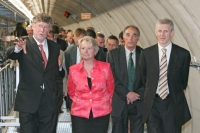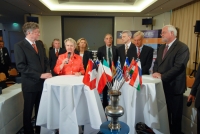 |
 |
|||||||||||||
|
|||||||||||||
|
|||||||||||||
|
On Tuesday 5 June, the German Federal Minister of Education and Research Annette Schavan officially launched the European X-ray laser facility XFEL. Using essentially the same uperconducting accelerator technology that is planned for the ILC, the 3.4-kilometre XFEL (for X-ray free-electron laser) will produce high-intensity ultra-short X-ray flashes with the properties of laser light. This will open up a whole range of new perspectives for fundamental research and for industrial users.
“Tuesday's XFEL launch is probably one of the most significant events for the ILC since the ITRP decision,” said DESY's Nick Walker. “It is a big success for the TESLA technology that both ILC and XFEL communities have worked on together in the last years.” Construction of the XFEL will start in 2008, and by 2013 the first beam will be accelerated. Shortly after, the first experimenters will sit at the first six of a planned total of ten experimental stations, probing chemical reactions at the atomic level, biomolecules and different states of matter. “The funding negotiations with the twelve interested countries are so far advanced that the construction of this new research facility, which is very much sought after by the international scientific community, can now begin,” said Schavan in front of representatives of the press and the guests of the launch ceremony. She, EU Research Commissioner Janez Potocnik, the French and Russian science ministers and an entourage of European and local VIPs also visited DESY, where they inspected the FLASH free-electron laser user facility and signed the DESY guest book. FLASH already uses superconducting RF technology and thus also serves as a prototype for the XFEL and ILC. In her address to the far more than 1000 DESY people, who had gathered in the tent set up for last week's LCWS and ILC workshops and also crowded into auditoriums on the Hamburg and Zeuthen sites, she congratulated and thanked everybody for their excellent work: “This is world class!” “This is a memorable and special day for Europe,” EU Commissioner Potocnik added in his address, “the XFEL is one of the most exciting projects in the European research area and is the first project from the ESFRI roadmap to be built.” He also appealed to the international team spirit of everybody working on the project: “Star teams are successful, teams of stars aren't - look at what happened to the Brazilian football team last year!” Reinhard Brinkmann, XFEL project leader at DESY, also issued a broad invitation to the ILC crew: “If people in the ILC community agree that the successful construction of the XFEL linac within schedule and budget is of utmost importance, they are most welcome to help us accomplish this task!” At first, an 850-million-Euro start version of the facility - the full cost for the construction phase is estimated at 986 million Euros - will be built, with excavations starting on the DESY campus. The 12 international partners will cover at least 25 percent of the costs of this initial version. The German share of up to 75 percent will be borne by the federal government and the two host states of Hamburg and Schleswig-Holstein. The European XFEL is based on the superconducting accelerator technology developed by the international TESLA Collaboration since the 1990s. “Today marks a milestone in the history of DESY,” commented the Chairman of the DESY Directorate, Professor Albrecht Wagner. “To see something new, you have to make something new, and this is just what we intend to do together with our international partners at the European XFEL. We are all very pleased that the good cooperation and hard work of many years is now bearing fruit. We are standing in the starting blocks to contribute our knowledge and expertise to the project's success.” -- Barbara Warmbein |
|||||||||||||
| © International Linear Collider |

